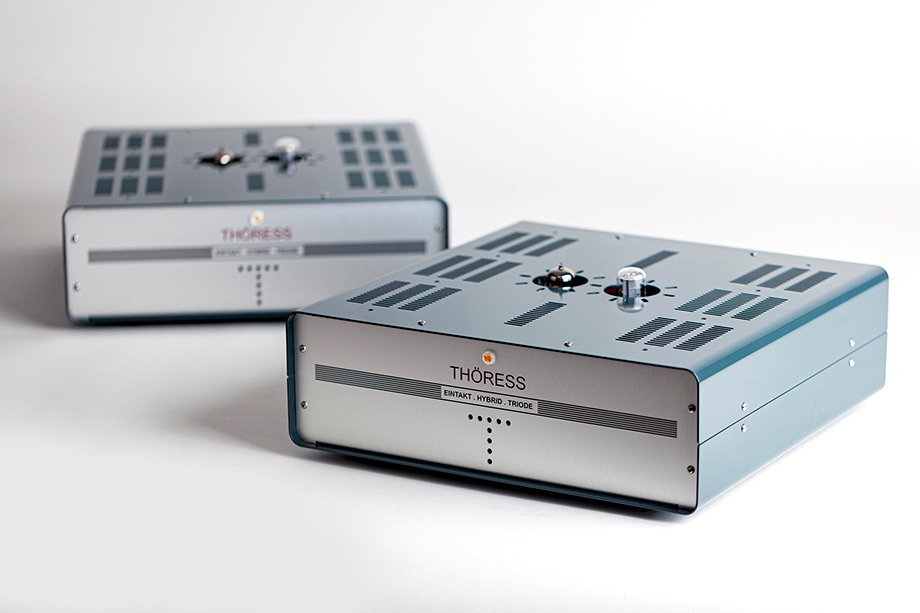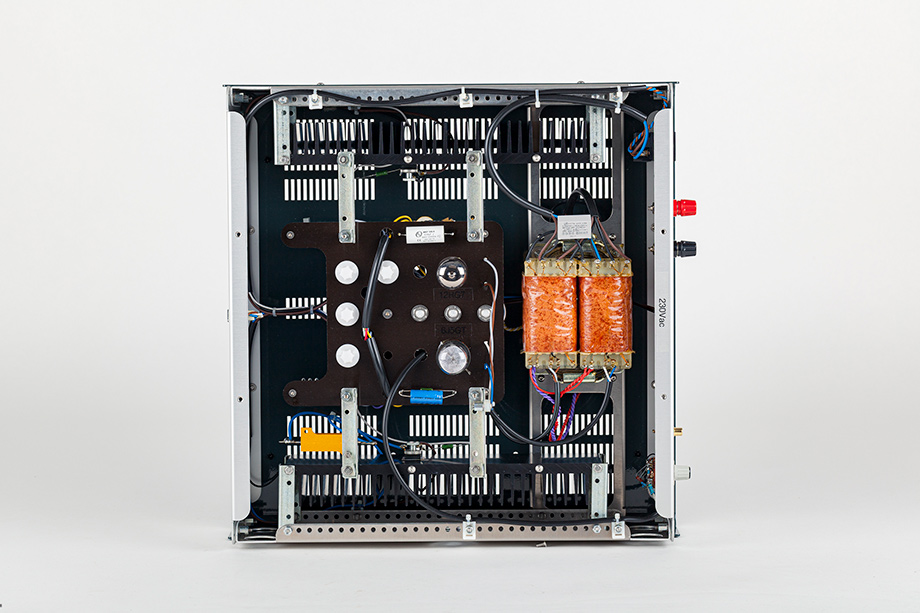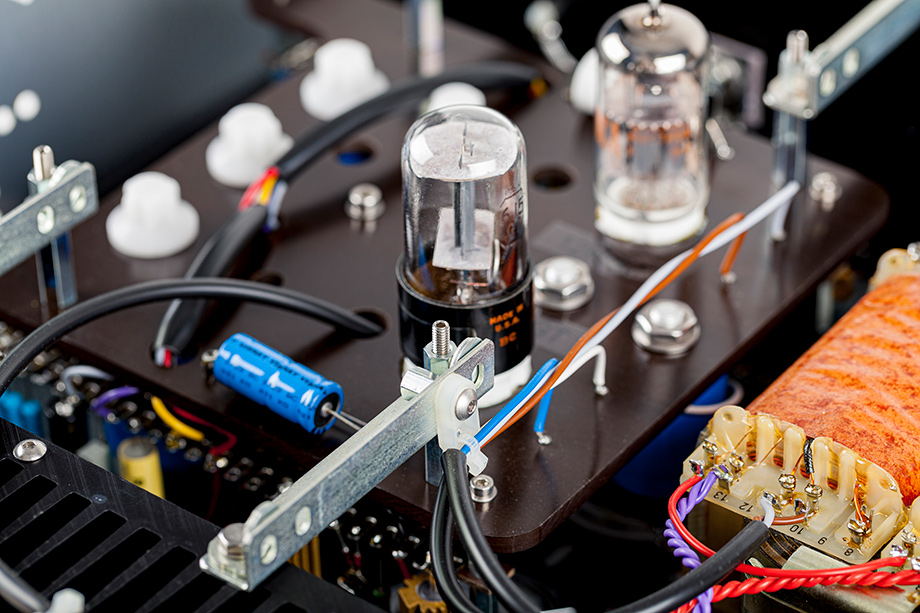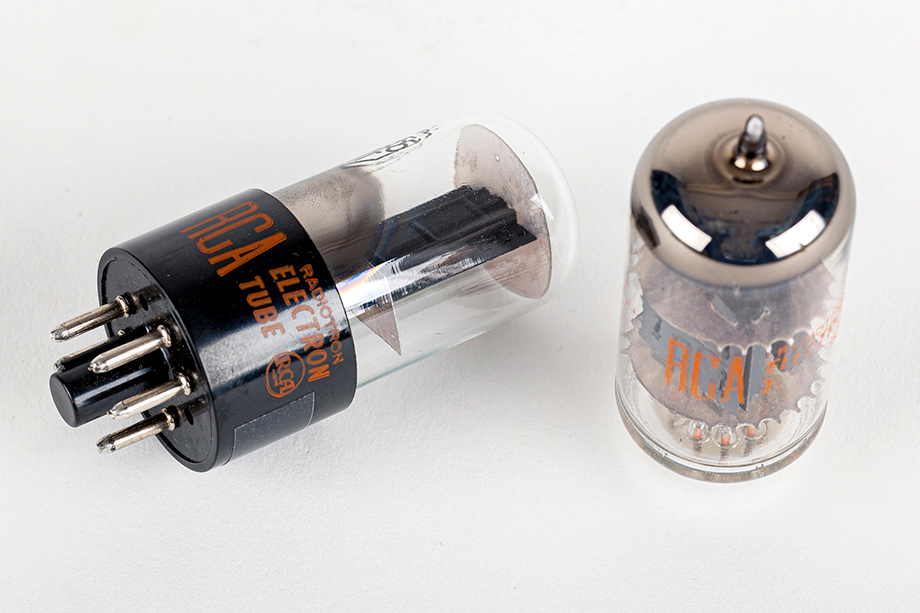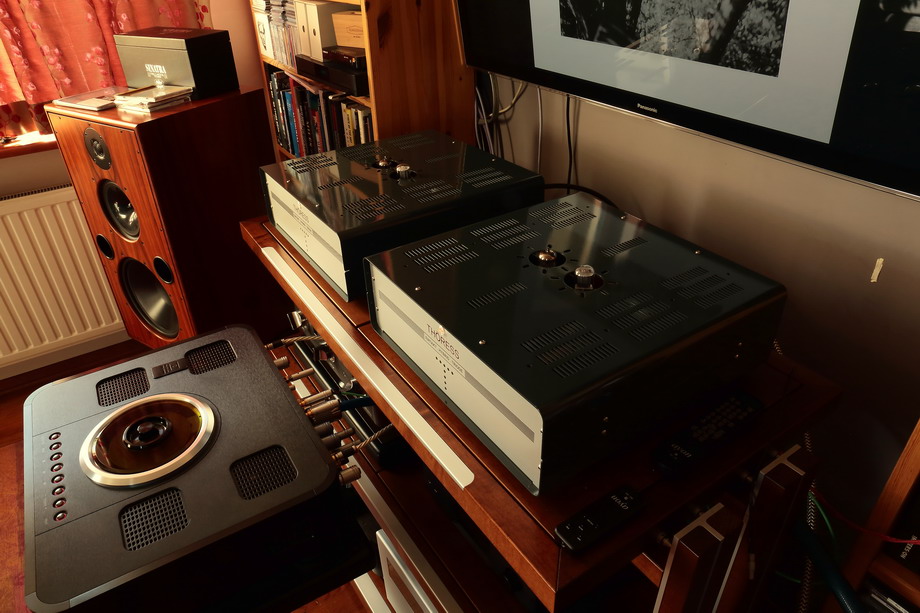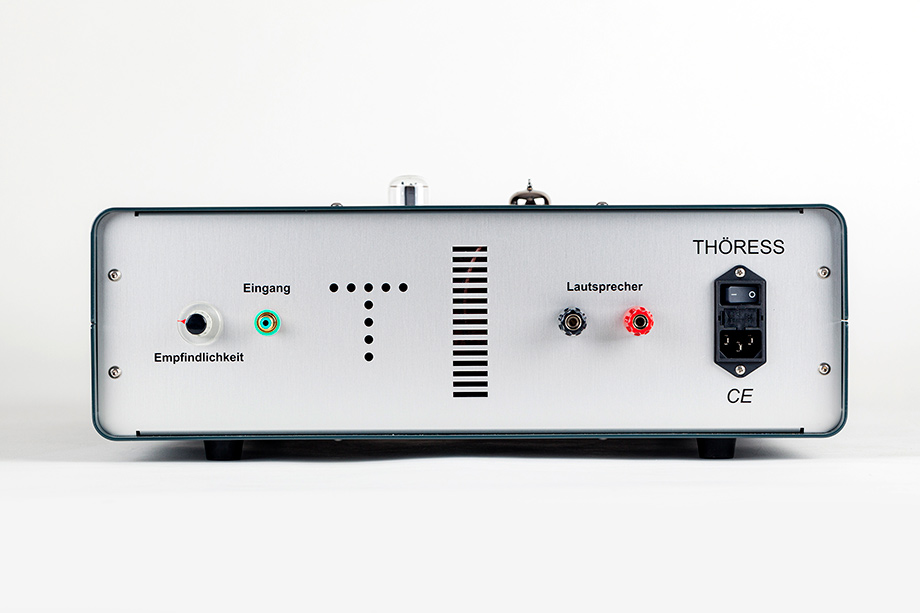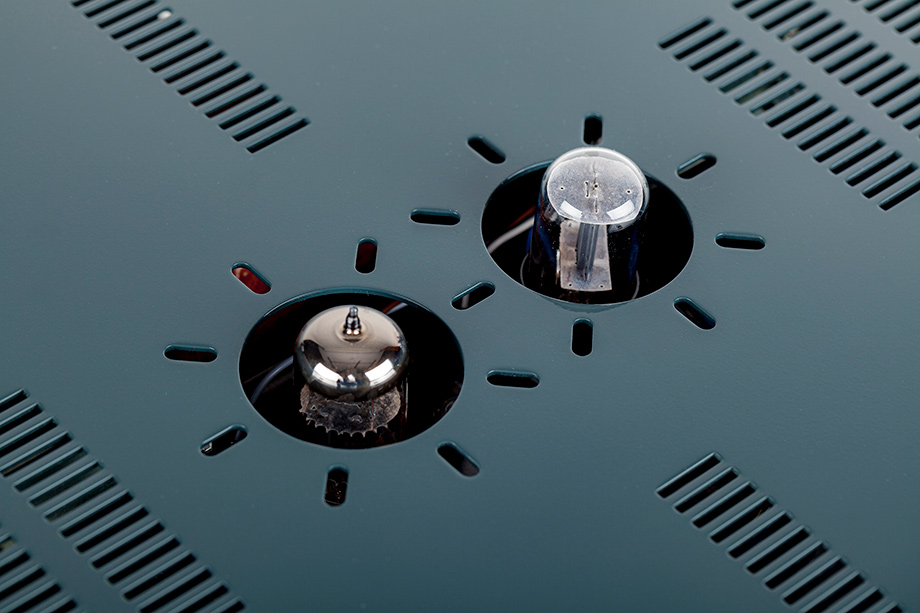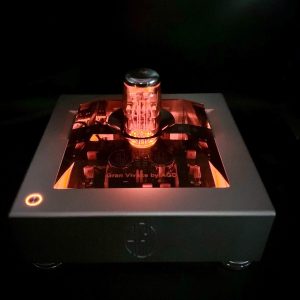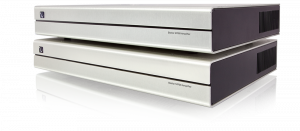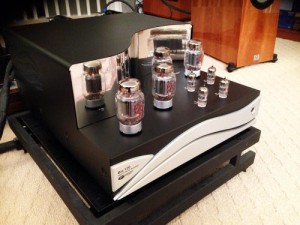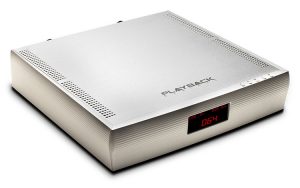Hybrid
- a thing made by combining two different elements;
- in biology: the offspring of two plants or animals of different species or varieties;
- a mythical creature being a combination of existing animal, such as griffin; […]
If there was an audio award that would be given to products for their design, the Thöress brand would have a chance to receive two—for the prettiest and the ugliest chassis at the same time. They look as if they were send straight from the 1950s through a time gap, most likely from one of the laboratories. As I belong to the first group of recipients who like retro solutions, as long as they make sense, Thöress products trigger only good thoughts in me.
Reinhard Thöress, founder, owner and designer in one person, believes that those were the golden years in audio, when it was not an accountant but an engineer who had a decisive voice in the company. This is why the devices he proposes feature such a solid build and so interesting solutions. At the same time, Mr. Thöress does not shy away from modern means—the chassis are made of a non-magnetic material, such as aluminum, and not of steel or cast iron, as in the past, because it has been proven that aluminum has a smaller impact on audio circuits. He also uses techniques popularized only in the 1970s and 1980s—in the case of the tested amplifier, field-effect transistors of the MOS-FET type.
And that's what I asked Mr. Reinhard Thöress about.
A few simple words…
REINHARD THÖRESS
Owner, designer
WOJCIECH PACUŁA I can see that there are two MOS-FETs per channel—are they working in parallel?
REINHARD THÖRESS No. The MOSFETS (IRFP260N) are not connected in parallel. They are stacked (with respect to the power supply). The MOSFET on top of this tower is the actual power bufferexcited by the tube gain section. The bottom MOSFET serves as a current sink which passes the idle current of the top device (around 3 Amperes). Both FETs are IRFP260N, ordinary readily available N-Channel Enhancement Mode types.
WP Is the second tube and transistor stage working as a transconductance
unit (Gain=1)?
RT Yes, it is.
WP So can we assume it is a tube amp (first stage) with buffer and current
source (output)?
RT Yes, exactly. However, since the MOSFET is used as N-channel source follower the respective current device is called SINK, not source, if memory serves :).
WP What is an origin of this circuit topology?
RT The circuit is so simple that it is self-evident... Take a MOSFET. Employ it as a source follower in a single-ended class A mode. As a PULL device (a complementary P-channel MOSFET, as in a case of a push-pull arrangement) is not allowed for passing the idle current it has to be a CURRENT SINK. Engage a second MOSFET to perform this job. And there you have it, the perfect buffer.
Excite the gate of this buffer with a vacuum tube gain stage employing a highly linear triode (such as the 6J5GT) at the maximum permissible idle current with an active anode load. Place another vacuum tube unity gain buffer (cathode follower) in between the 6J5GT triode and the power buffer to drive the MOSFET gate with the lowest possible output resistance. For this job choose a highly linear tube with high amplification factor and high mutual conductance (such as the 12HG7) in cathode follower schematic, this time with an active cathode load, at high idle current. There you have it, a perfect gain stage followed by a perfect cathode follower buffer, driving a perfect power buffer. That's all. I have merely "decided" to employ this circuit. There was nothing left to choose, to invent or to create. The only merit I can claim for is that I have implemented the circuit decently.
WP OK, so last but not least—why point-to-point assembly? Why not use PCBs?
RT PCBs are perfect when it comes to schematics with an army of ICs with many legs. But they are not suitable (if not a pain) for vacuum tube technology, in my opinion. Particularly not for my approach. Parts are big, they run hot and need proper ventilation. Voltages and currents are high, etc. All that kind of doesn't fit into the PCB frame. RT
EHT Mono
HYBRID
The EHT Mono is the latest addition to the company's portfolio, which was presented for the first time at the High End Show 2019 in Munich. The EHT is a monaural power amplifier a hybrid design. It offers a moderate power output: 30, 40 and 50 W at loads of 8, 6 and 4 Ω respectively. Mr. Thöress likes acronyms—EHT means "EINTAKT. HYBRID. TRIODE "(German: single-ended hybrid triode). Contrary to previous tube devices, such as the 854 Mono monoblocks we tested (HERE), this is a hybrid amplifier.
The term 'hybrid' has been popularized in recent years by the automotive industry, where it denotes a car in which there are two types of engines—an electric and a combustion ones. Because "hybrid" is "an individual formed as a result of crossing two different genetic parental forms, eg varieties, races" (Polish Language Dictionary by PWN). In audio, 'hybrid' most often refers to an amplifier in which the input (voltage) stage is designed using a technique other than the output (current) one.
In most cases there are tubes in the input and transistors in the output. The only exception are the KR Audio amplifiers, where the opposite is true. The advantages of this solution include the linearity of the tubes, which work best in the voltage stage, and the current efficiency of the transistors. In short—the hybrid amplifier is to mix the "magic" of tubes with the ability to drive a wider range of loudspeakers than tube amplifiers.
However, Thöress's "Hybrid" is something completely different. Firstly, it is a device in which all gain is entrusted to the input tube, and the other two stages operate with a gain equal to '1'. Moreover, the output transistors, two per channel, work in single-ended mode. Mr. Thöress has prepared a special article in which he argues why balanced (push-pull) circuits are a bad idea (Thöress - Behind the Curtain). Because the EHT Mono is, apart from everything else, a very interesting design featuring some rare solutions.
DESIGN
I mentioned a low—for a device with transistors—output power. The EHT Mono is something else, something more than an "ordinary" hybrid amplifier—it is a tube amplifier with a transistor "booster". The signal path is very short, as it consists of two single triodes and two transistors "stacked" in the output. The entire voltage gain was entrusted to the 6J5GT tube. It is an octal tube, a half of the popular 6SN7 double triode, originally designed for detectors, amplifiers and oscillators—it is responsible for the "sound" of the device.
After it there are next three stages, two of which are stages working with the gain=1, or 'unity-gain.' The first one is built using the 12HG7 tube, rarely seen in audio, a tube with a relatively new design, presented in 1964. This is a medium power pentode, operating in a triode mode here. The signal from it goes to the next buffer, this time transistor-based (another MOSFET), and finally there is a current source, also based on a MOSFET transistor.
The transistors in this circuit do not amplify the signal (unity-gain mode), and only supply current. It is a rarely used, but sonically very promising technique. We dealt with it in the amplifiers of the Canadian company Tenor Audio 175S (tube circuit) and the amplifiers of the Italian company Audia Flight (transistor circuit).
The tubes operate in comfortable conditions, provided by a system consisting of transistors and diodes, which stabilize the voltage, and also work as active current sources. As usual in the case of tube products, the sound can be tuned with the choice of tubes. The sound of this particular pair of monoblocks is to some extent conditioned by the fact that both tubes, both the input 12HG7 and the buffer 6J5GT, are NOS Radiotron RCA tubes. Let me add that exactly the same tubes were used in the Dual Function Preamplifier (DFP) from this manufacturer.
An important element of the design of the tested monoblocks is the power supply. It is based on a large double C transformer self-wound by Reinhard Thöress. This is another unusual choice, because audio designs are dominated by toroid and classic transformers, i.e. EI and sometimes R-core ones. "Double C" is a more difficult choice, and one can find it in devices from the French company YBA (for example Passion PRE 550 & Passion AMP 650).
Unusually for this type of products, the assembly was carried out using the point-to-point method, with the use of rails, characteristic for tube devices. It is time-consuming, because it is done by hand, and therefore expensive, but yields better results than assembly on a PCB. The entire circuit in the EHT Mono is not mounted on the base plate, as usual, but rather "suspended" on metal brackets, bolted to the heat sinks. This protects the tubes against vibrations to some extent. There are also large, high-class power grid ripple suppression capacitors, bolted with plastic screws from the bottom to the Bakelite plate. The power transformer is mounted separately on a metal frame and via rubber washers.
APPEARANCE
The EHT Mono amplifiers are typical products in terms of their look for this manufacturer. Their chassis are made of aluminum sheets with rounded edges and painted in a nice, dark green color; a similar color is used by the Japanese company Shindo Laboratory. Along with the gray front and characteristic prints, we have an impression that it's a product straight from the 1950s that we have in our hands.
The devices are quite large, as they measure 434 x 184 x 434 mm (W x H x D) and weigh 14 kg each. It's not much, but in this case it is about relatively low power, and thus smaller heat sinks and power supply than in more powerful amps. In the front there is only an orange (actually red) indicator, signaling that the power is on, and there are holes that combine together into a shape of a letter 'T'. There are also holes in the top and bottom panels. The idea is to cool the interior as much as possible—large heat sinks for the transistors are placed inside, and the tubes are also recessed into the housing. They peak through the top panel to let the user know that this is primarily a tube device.
The back of the device is very simple. There is an unbalanced RCA input, a pair of loudspeaker sockets and an IEC power socket with a mechanical switch—this is the only switch in this device. I wish it was placed somewhere in the front. The gold-plated RCA socket is green (as in Haiku-Audio devices), and the speaker terminals are not gold-plated—these are actually sockets used in measuring devices.
There is one more elements on the rear panel: a four-position rotary switch. One can use it in four steps to set the gain of the device choosing between: 2, 10, 18, and 26 dB. This will help you adjust the system to your speakers. Let me add that the amplifier does not use feedback, and all components found in protection systems have been eliminated from the circuit; nevertheless, the device is fully protected against short circuits.
These are well-made amplifiers with a unique layout—both purist and refined. It's a minimalism at its best.
SOUND
HOW WE LISTENED TO IT
The Thöress EHT Mono monoblocks were placed on the top shelf of the Finite Elemente Master Reference Pagode Edition rack, next to each other. They were powered by two identical Acoustic Revive Absolute Power cables, 2 m each, directly from wall sockets, with a separate power circuit. The Ayon Audio CD-35 HF Edition SACD player, which normally stood on one of these shelves, was placed on a temporary stand consisting of the Sonus faber speaker stand and the Acoustic Revive RAF-48H pneumatic platform.
The signal to the Harbeth M40.1 loudspeakers was sent using the Siltech Triple Crown cable, but I achieved excellent results also with the Western Electric WE16GA NOS cables.
Recordings used in the test
- BOGDAN HOŁOWNIA, Chwile…, Sony Music Polska 5052882, "Pre-Mastering Version", Master CD-R (2000)
- CANNONBALL ADDERLEY, Somethin' Else, Blue Note/Esoteric ESSB-90125, SACD/CD (1958/2015) w: 6 Great Jazz, "MasterSound Works," Blue Note/Esoteric ESSB-90122/7, 6 x SACD/CD
- HILDEGARDA VON BINGEN, Canticles of Extasy, Deutsche Harmonia Mundi 77320 2, CD (1994).
- J.S. BACH, Sonatas & Partitas vol. 1 BWV 1004-1006, Isabelle Faust, Harmonia Mundi HMC 902059, CD (2010)
- JEAN-MICHEL JARRE, Magnetic Fields, Dreyfus Disques/Epic EPC 488138 2, CD (1981/1997)
- NEW ORDER, Power, Corruption & Lies, Factory FACT 75/Rhino Records, Promo CD-R (1983/2008)
- SŁAWEK JASKUŁKE, Park.Live, Sea 54.439954/Core Port RPOZ-10053, CD (2020)
"I know this kind of sound," I thought to myself, listening to the first album. It so happened that it was an album by Sławek Jaskułke Live.Park, released in Japan by Core Port. The album was recorded on July 25th 2019 during a concert that took place in the courtyard of the Sopot Museum. There are a lot of various elements in the recording—piano, seagulls, playing child and listeners; it is a kind of "sound installation" in which various characters take part, and each has a role to play.
Our albums
SŁAWEK JASKUŁKE Park.Live. Core Port RPOZ-10053. Compact Disc
CORE PORT IS A JAPANESE label specializing in jazz music. Interestingly, its offer also includes Polish musicians. I found it while looking for Sławomir Jaskułke's albums—they have almost all of them—but also Hania Rania's albums HERE. There are also two compilations that are very interesting: Polish Pianism and Polish Lyricsm, where we can find tracks from various Polish labels.
Park.Live Nature Concrete Music Vol. I is Jaskułke's latest album, a solo one, the first in the field of concrete music (a creative direction in which space is one of the means of expression, in which the music is performed or for which it is composed). As Jaskułke says: "Recording music in an open space is quite risky because it is burdened with many technical and acoustic aspects. However, it makes it possible to enrich sounds with a value that is impossible to obtain in studio conditions—sounds of nature. "
Recording outdoors is not a new idea, but treating non-musical elements as equivalent to music itself is interesting; in some ways they are part of it too. As a result, an extremely intimate, but at the same time "open" album with great music was created, and also fantastically produced. The sound of the piano is warm, dense and very dynamic, plus the high-sounding ambient sounds - really great! It is strange that Jaskułke has not yet been invited to the Polish Jazz series, he trylu deserves it.
The album was released in Japan on January 15th this year, and in Poland only on July 10th. Its music producer is the musician himself, and IGOR BUDAJ is responsible for the sound. He is a sound engineer and an actor, dubbing some cartoons and games. He worked for Aidem Media and Active Sound Studio, currently he is associated with the Baltic Philharmonic Fryderyk Chopin in Gdańsk. www.coreport.jp
JASKUŁKE'S PIANO usually sounds quite dark and dense. I mean not only the Sea disc, recorded in a specific way, with a piano covered with a duvet (it was supposed to be just a warm-up before the actual session), but generally about the sound of the instruments he plays. I do not know if it is a derivative of his playing technique, whether it is influenced by the choice of instruments, or finally is it a conscious choice of producers, but it is just like that.
I know this type of sound, because I hear it with devices whose designers wanted to reproduce not so much the "letter" of the recording, but rather its "spirit." Based on the assumption that since it is not possible to render reality perfectly, it must be made credible—and 'perfection' and 'credibility' are two different things in audio. If these were absolutes and if we lived in an ideal world, than yes, we would be talking about synonyms. In the real world, however, we only deal with approximations. A credibility approximation for designers such as Reinhard Thöress seems the most appropriate way, because it is very "human."
The sound of the EHT Mono is therefore characterized by incredible saturation. Something like this is difficult to achieve in audio, regardless of whether transistors or tubes are in play. It's a state of mind rather than a technique. With the tested amplifiers, the Jaskułke piano had not only a warm, dense sound, it was also complemented and densified. I mentioned the aura that consists of the sounds from the environment on this album—with Thöress amplifiers it was cool, but less important than the foreground.
Apart from the outstanding saturation, one of the basic features of the EHT sound—as well as a large part of this type of amplifiers—is bringing the foreground closer to the listener and making it bigger. If I haven't said it directly yet, I'll do it now—it's not an amplifier that celebrates details, that focuses on every creak of a pianist's chair, over every breath of a double bass player. If these elements are present in the recording, EMT Mono will pass them on to us. It's just that they will do it "casually", next to the music.
Everything in the presentation of these devices is—just like the gulls soaring overhead during the Jaskułke concert, and the bells in the recording opening the album Chwile... by Bogdan Hołownia, and then the cymbals in the Somethin 'Else from the Cannonball Adderley album, played from the great Esoteric SACD re-edition, there in the sound. But fullness was more important, volume was more important, consistency was more important.
When in the track Autumn Leaves the leader plays his saxophone, going down, even though it is an alto saxophone, it had a very deep sound, it was heard as if he was standing two meters away from me. On the other hand, Miles Davis' trumpet, played here with a muffler, sounded sensational, because it was strong, bright, but not aggressive. And Hank Jones's piano - it sounded like something from the albums I mentioned earlier.
The thing that says a lot about the character of the EHT Monos was how interested and involved I was listening to the sound of the double bass and kick drum as the driving force behind the recordings. Both instruments are played really well by these amplifiers. Normally, I would say that they are emphasized, but the technique used in the tested devices results in something other than coloration—it provides richness, and gives the recording a strong, solid, dense foundation of the truth about the sound.
Jean Michel Jarre from the Magnetic Fields sounded incredible! The Scott Hull's remaster from the Masterdisk studio is warm and rather dark in itself, but with the German monoblocks the bass was also saturated. I cannot imagine that anyone would be missing anything in this part of the range with these amplifiers. For many music lovers it may be a surprise how much information about space, dynamics, volume, and also treble, is "encoded" in the lower range of the band. The EHT Mono show that without it it is difficult to talk about a credible presentation.
Summary
So there is a saturation, warmth, density, strong bass, warm, silky treble and the primacy of the foreground. This results in an incredibly natural sound. But the sound is focused on timbre, not detail. You have to remember that. Reinhard Thöress's hybrid monoblocks offer a holistic view of the musical material and its reinterpretation. Their sound is soft rather than focused, rather warm than open, and rather close to us than presented in a perspective.
This is the sound for long, very long listening sessions, not only for playing loud, but also when the volume knob is set to the minimum. Even with quiet listening we get fullness and density with them, which is hardly ever present with other amplifiers. Go up with volume and the dynamics will appear, and the sound will fill the space in front of you. The amplifiers handled the difficult Harbeth M40.1 loudspeakers very well. They create events in their own acoustic environment, which is completely transferred to our room. It's a beautiful, organic, that is—a comprehensive and internally properly arranged—sound for those who value tonality above all else.
Thöress EHT Amplifiers
Price (in Poland): 57 990 PLN/pair
Reinhard Thöress
Martinstrasse 17
52062 Aachen | GERMANY
MADE IN GERMANY
Text: Wojciech Pacuła
Images: Piksel Studio | Wojciech Pacuła




